How Many Types of Visual Arts Are There Numbers Famous Painters 2016
twenty of the World'south Almost Famous Art Pieces
Art history has delivered united states some amazing paintings and sculptures, then limiting the list to xx pieces is no pocket-size feat. Certain works volition ever rise to the top. In this list of the xx most famous pieces of Western art, see how many you recognize. Do you agree with the list? Which work would be your twenty-first?
Mona Lisa by Leonardo da Vinci

It is no surprise to see the Mona Lisa at the top of this list. Da Vinci'southward masterpiece is probably the nigh recognized artwork in the world today, and the virtually visited. Likewise known as La Giaconda, the painting is believed to illustrate the married woman of wealthy Florentine merchant Francesco di Bartolomeo del Giocondo. Alternative suggestions include Leonardo's mother and a self-portrait of the creative person. Why is this work and then revered? It is a combination of the Mona Lisa and the afar backdrop that frames her, and the harmony that exists in the perspectival representation Da Vinci rendered so well. The Mona Lisa revolutionized portrait painting for time to come artists. His option of wear is not fashionable but rather timeless. This mysterious woman has later on get the subject of song and movie titles and the works of other renowned artists, including Marcel Duchamp and Andy Warhol.
The Creation of Adam past Michelangelo

The Creation of Adam is the central chemical element in Michelangelo's large Sistine Chapel fresco. It is one of the most replicated biblical paintings in history, at present blazoned on anything, from placemats to umbrellas. Hither God breathes life into Adam, and the creation of man is central to the biblical creative narrative. God floats in a cloud of drapery and other human figures. He is portrayed every bit an older homo, draped in a elementary tunic, muscular even so existent. The outstretched hands connect God to man and humanity. Michelangelo'due south painting of Adam, created in the image of God, must exist one of the most famous nudes in art history. Eve, created from Adam'southward rib in the biblical narrative, is believed to be the figure tucked under God's left arm. Given that Michelangelo was first and foremost a sculptor, his strongest skills in painting are the musculature and twisted forms in the reclining nudes. A major cleaning projection of the work completed in the belatedly 1980s revealed Michelangelo's original bright color palette.
The Nascency of Venus by Sandro Botticelli

Botticelli's famous painting, The Birth of Venus, was commissioned past the influential Florentine Medici dynasty. Painting with tempera on canvas, rather than the more conventional woods panels used (like the Mona Lisa), showed a break away from traditional materials that were becoming popular at the time. The work is revered equally a keen treasure of the Renaissance, depicting a nude at the center of the painting referencing the ancient world. The Renaissance saw the "rebirthing" of the earth of antiquity, not only in art, but too in architecture, philosophy, and poetry. Works past writers like Homer were regenerated and provide the background story for this picture show. Venus is located at the heart of the piece, riding upon a shell to the shore, after her nativity from sea foam. She is blown from her right towards land by Zephyrus and the nymph Chloris, who guide her to shore. Pomona, the goddess of Jump, waits on shore for Venus' arrival. Take notation of her contrapposto stance, the detail in her hair and her unusually large neck.
Guernica by Pablo Picasso
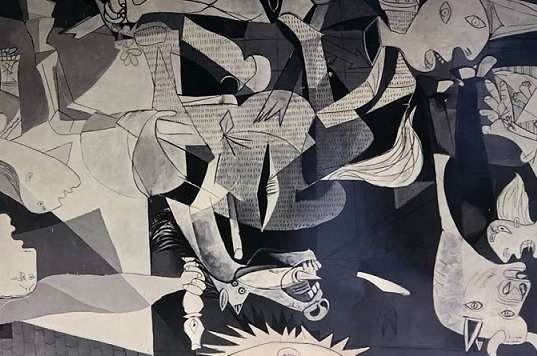
Guernica, a political protest piece in Picasso'due south singled-out cubist style, was a central allure at the Paris World Fair in 1937. This large-scale monochromatic palette of gray, white and black was Picasso's response to the recent bombing of the Northern Spanish town, Guernica. The attack by Hitler's military, sanctioned by Franco's authorities against his people, was the first aerial saturation of a civilian population. Information technology served as a "grooming mission" for Hitler and reduced the village to rubble, wounding or killing a 3rd of the population. The painting is not easy to decipher, simply the figures' pain and grief are singled-out. The far left figure is of a woman who is screaming and holding a lifeless child in her arms. A bull remains unharmed and calm while a equus caballus in the centre of the work is terrified and distressed. Dead and wounded figures, mutilated bodies and distorted faces writhe in agony. Guernica traveled the globe to raise sensation of the state of war, contributing to its worldwide fame. MOMA held information technology for xix years in New York until civil liberties and democratic processes were restored in Spain.
Daughter with a Pearl Earring by Johannes Vermeer

Girl with a Pearl Earring, or the "Mona Lisa of the Northward," is painted past the 17th-century Dutch painter Johannes Vermeer. A deceptively unproblematic portrait, Girl with a Pearl Earring is enigmatic. No name is given and all the audience sees is a girl who has a pearl earring and is staring back. Speculation effectually the girl's identity ranges from beingness Vermeer's mistress to being one of his 15 children. The girl's hair is tied back in a blue ring contrasting with the gilt of her dress and is get-go by the dark background, giving the painting its luminosity. Her oral cavity is open every bit though she is almost to enquire a question, but what is she thinking? The painting is a tronie rather than a portrait, depicting the subject'south head dressed in its Eastern turban. This headdress, together with the exceptionally large pearl, conjures up the exotic. The painting crossed the globe during the restoration of the Mauritshuis, gaining virtually-motion-picture show star status. The Girl with the Pearl Earring experienced further fame with the release of the films Girl with a Pearl Earring and St Trinians.
Campbell's Soup Cans by Andy Warhol

Campbell'southward Soup Cans is just one in a series of paintings Andy Warhol fabricated so incredibly famous through his use of the visitor'southward branding. Painted by manus, with the use of stencils, closer inspection reveals that these cans are not identical in appearance or spacing. Each tin can represents 1 of the 32 flavors that Campbell's had on offering in 1962. As a pop artist, Warhol became interested in the machine-like processes involved in mass production of such things equally the Campbell'due south soup tin itself. In the climate in which Warhol was producing these works, the American public was becoming more and more than reliant on mass-product. For Warhol, this would lead to society's ultimately condign more than depersonalized and homogenous. Warhol saw the connection to the mechanical and the awareness of advertizement, design, branding and mass product that the middle class was engaged in.
The Thinker by Auguste Rodin

The Thinker is an iconic sculpture of a crouching figure, highly contemplative upon its rock plinth. At most 20 anxiety tall, the body is larger than life-size. The man sits deep in thought, twisting his torso with his right elbow resting on his left knee, and his mentum resting on his right mitt. Rodin'south nude references sculptural works of Michelangelo and classical antiquity. Anticipated originally as part of Rodin's Gates of Hell, Rodin is likewise referencing Dante'due south Divine Comedy. The Thinker can exist seen at the centre of the top panel of these doors. When Rodin died, he gave the rights to cast further sculptures of The Thinker and other works. Castings of the sculpture can now be found across the globe, not just in the Rodin Gardens in Paris. Some 28 castings can be plant anywhere from Melbourne, Australia to Buenos Aires, Argentina, cast in both plaster and bronze. Some other casting adorns Rodin's tomb in Meudon. In contempo times a bronze casting, made for Ralph Pulitzer, sold for USD fifteen.3 million.
Number 1 (1950) Lavender Mist by Jackson Pollock
-lavander-mist-past-jackson-pollock.jpg)
Jackson Pollock's painting style was both confronting and controversial for the 1950's American public. Breaking abroad from the traditions of the pictorial past, Lavender Mist embodies Pollock's chosen style, which he had worked on since 1947. Pollock explored the characteristics of the paint itself and the surface it was practical to. Full of free energy, the characteristic "dripping" technique was applied to a big calibration canvas on the floor while Pollock walked around it. He applied pigment directly from the industrial pigment tin can, throwing, flinging and pouring pigment beyond the surface with his sticks, brushes and turkey basters. In the heat of the action, he would fling other things in too, including sand and the occasional cigarette barrel. In the tradition of ancient cave painters, Pollock signed the work in the upper left-paw corner with his handprints. All-time seen up close, his action painting is rich in color and texture, which is lost in a photo in a book or on a website. This action painting was a subset of the broader movement known equally abstract expressionism.
Starry Night by Vincent van Gogh

Van Gogh's magnum opus, Starry Nighttime, is another exceptionally famous piece of work that has constantly been replicated on numberless, mugs, umbrellas and all manner of objects, a attestation to its fame and popularity. Information technology depicts the scene he saw from his room during his stay at a sanatorium. Van Gogh, non existence the most robust of characters mentally, tried to chop off his ear, and eventually took his own life. Starry Nighttime uses a strong color palette, with great free energy created by the swirls of his brush. These characteristics have influenced generations of artists, making Van Gogh one of the most well-known and influential painters in Western art. Having completed thousands of works, Starry Night forth with Café Terrace at Night and Sunflowers are amid the virtually well-recognized paintings in the world, fifty-fifty an entire episode of Doctor Who was dedicated to the artist and his inner demons. Despite his skills, Van Gogh managed to sell only one of his works during his lifetime; ironic, given how they are now and then revered that a unmarried painting will command a USD 100 million price tag at auction.
American Gothic by Grant Forest

Named from the style of the building in the background of this painting, American Gothic has long been a cultural icon of a nation. Painted in 1930s America, Wood's painting represents America, Middle America, and pocket-sized-boondocks America all at the same fourth dimension. Along with Thomas Hart Benton and another artists, Wood's style was linked to the Regionalist painting genre. Pictured here are a farmer and his daughter (although the bodily models were Woods'due south dentist and his girl). Part of the fascination people have for the work is the contradictory readings people aspect to it. Some feel that Wood was mocking the Midwest, while others call up it accurately represented the Midwesterner that he saw and painted. Either way, the work suggests hardworking individuals who toil the land, a bourgeois America that contrasted with the growing industrial culture of the time, and a symbol of the American heartland.
Nighthawks past Edward Hopper

Hopper'due south Nighthawks is some other of the most famous American paintings of the twentieth century, depicting a snapshot of 1940s American civilisation. It depicts a quiet night scene, which some believe may have referenced Van Gogh's Café Terrace at Night. Its simplicity of form is deceptive when it comes to agreement the narrative that is being told. Both Hopper and his married woman were models for the painting. Like many of Hopper's works, Nighthawks conveys the feeling of isolation, particularly in a crowd or a large city. For example, in that location is no door to the outer world of the big metropolis, heightening a sense of isolation within the frame. The difference between the warm-colored interior and the cooler exterior highlights the sense of loneliness. The placidity chat that the characters might be engaged in leaves us outside looking in. In that location is no sign of life in the buildings across the road. Hopper leaves questions unanswered for the viewer. Did the couple arrive together, or did they meet there? What about the man sitting alone? Why is he there late at nighttime? This air of mystery has kept many a person guessing, and contributed to the painting's fame.
Water Lily Pond by Claude Monet
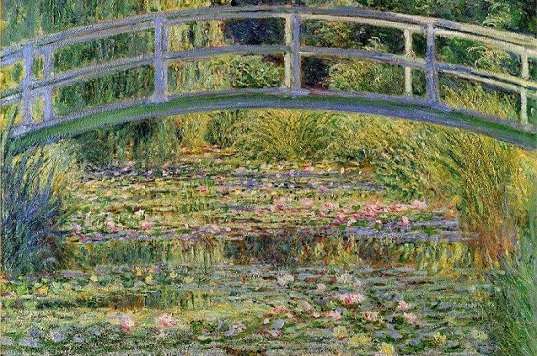
Monet's Water Lily Pond belongs to a serial of paintings that Monet created at his property in Giverny. They capture the impressions lite left reflected upon the water dappled through the tree branches and leaves. This particular work incorporates Monet'due south famous Japanese bridge and the weeping willows that have become instantly recognizable to millions around the world. The suite of Water Lilies is on permanent display at the Museé de 50'Orangerie in Paris. It was produced subsequently in the artist'south life. H2o lilies were a constant subject for the creative person. A continued turn down in Monet'due south eyesight due to cataracts eventually affected how he saw the pond. The awesomeness of the original works' harmony and intensity of colors eventually became darker, bluer and more blurred and abstract in their execution. Despite this, Monet'due south contribution to art came from his ability to capture fleeting moments of time in the permanence of his canvas, making him a truly remarkable impressionist.
The Scream by Edvard Munch

Second, only to the Mona Lisa, The Scream is the almost iconic homo effigy in the history of Western fine art. This at present famous expressionist painting by Edvard Munch is part of the creative person's autobiographical series the Frieze of Life. The Scream depicts a character who has recently walked along the bridge that extends from the left of the painting to the foreground. Curvy energetic forms rush around in the groundwork in reds, blues, and yellows. Munch said the scene came from a moment of overwhelming feet and melancholy he experienced while out for a stroll with friends one evening. Stolen twice in dramatic heists from the Oslo Munch Museum, the painting has had its share of notoriety. The Scream also bankrupt the tape for the most expensive painting sold at auction in 2012 when it sold for just shy of USD 120 million. The Scream has also been parodied in other artists' work, adding to its notoriety. Andy Warhol was deputed to produce silk prints from a lithograph of the painting. Munch made the lithograph himself, allowing him to sell black and white copies at will. In Wes Craven's Scream franchise, the killer wore a mask referencing on The Scream'southward haunting face.
Venus de Milo past Alexandros of Antioch
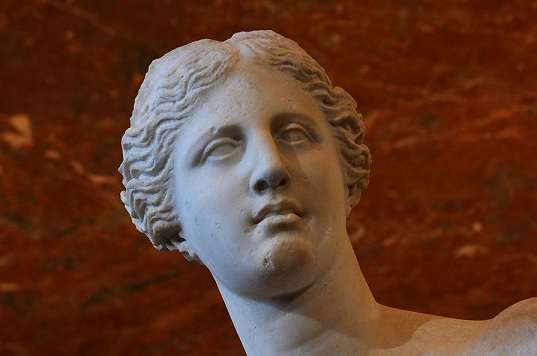
The Venus de Milo, idea to represent the Greek goddess Aphrodite, is the oldest inclusion on this listing. One of the most famous sculptures in the world today, the Venus de Milo originated in Ancient Hellenic republic. She was discovered on the island of Melos (Milo in modern Greek) and is now housed in the Louvre in Paris, with millions of people visiting her every yr. Carved sometime effectually 100 BCE by the sculptor Alexandros of Antioch, Venus is a partially clothed adult female who is missing her artillery. Much discussion has surrounded what she was originally doing, or holding, with them. The form of this sculpture lives up to the paradigm of Aphrodite the Greek Goddess of Beauty, Venus being her Roman namesake. Certain schools of thought, still, believe she is Amphitrite, the Goddess of the Sea, while others accept claimed she is a prostitute. Whatsoever her origin, in that location is no question she is 1 of the most iconic statues in the earth.
David past Michelangelo Buonarroti
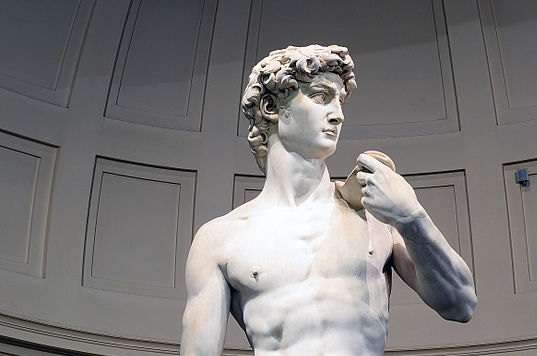
David is the second of Michelangelo's works, with a spot in the acme 20 most famous art pieces. This time, Michelangelo shows his mastery over the sculpting of human being forms from marble. His success in sculpture would ultimately influence his painting of the Sistine Chapel, particularly the rendering of muscular forms in his majestic fresco. Nearly three times the size of the average person, David is no mean feat, especially given the initial intention to identify the sculpture higher up the roof line of the Florence Cathedral. Michelangelo'south skill in chiseling can be seen in David's cute course, its muscles, and David'southward expression. Information technology serves as a stellar example of High Renaissance fine art and the utilise of the contrapposto pose. The slingshot that David used to kill Goliath in the Old Testament story can be seen slung over David's left shoulder. He holds on to the stone he uses to kill the giant in his right mitt. More recently, visitor numbers take been restricted to reduce vibrations, given the small fractures establish in David's talocrural joint.
The Persistence of Retentivity by Salvador Dalí
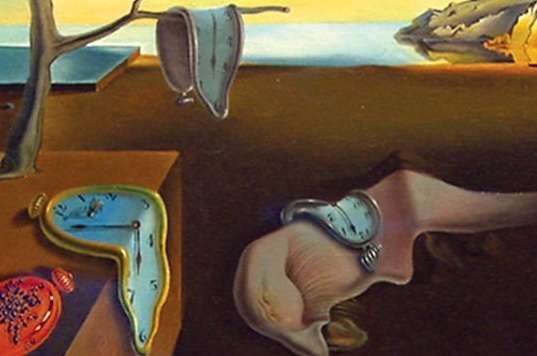
Looking for a world-famous, tiny painting that packs a huge punch? Enter the self-proclaimed genius Salvador Dalí and his famous droopy clocks in crazy dreamlike landscapes. Of all his piece of work, The Persistence of Retention is arguably his nearly famous, executed with Dalí's usual detailed precision. The initial reaction is ofttimes, "What am I looking at?" The painting immediately turns our sense of normality on its head with its malleable clocks and the strange organisation of objects inside this dreamy mural. The Persistence of Memory challenges many viewers on first glance, and yet its sense of fun draws you in a seductive attack on what is real. An autobiographical aspect, the sea and hills are reminiscent of the creative person'southward Catalonian dwelling house landscape. At the center is the deformed character, with its large olfactory organ and its eye with its equally large eyelash that extends to the contours of the nose. Dalí's famous clocks were supposedly born out of the artist'due south response to looking at melted cheese. And and then, of course, there are those links to Freud, the unconscious and the dreamscape, where irrational thoughts in our minds play out.
The Kiss past Gustav Klimt

The Kiss is an exotic and opulent-looking work with rich oils and layers of practical gold foliage. The Kiss is an instantly recognizable work with endless reproductions on posters, bags, ceramics, and vases that take been produced around the world. Strikingly mod, influenced by the curvy sinuous lines of Fine art Nouveau, the work has a potent organic feel to information technology. Painted in an almost perfect square, Klimt's masterpiece differs from the more common rectangular surface. The Kiss captures the light through its overarching gilded hue, giving the painting its luminous quality. Klimt'south use of golden was no doubtfulness inspired by his trip to Italian republic, and the stunning Byzantinian mosaics institute in Ravenna'due south basilica. Key to the work is a woman intimately embraced by her male person companion. Their elaborate robes are delineated with the female'due south curvilinear and round forms, and the rectangular decorative elements of the male's cloak. The couple, lost in the intensity of the moment, kneel on a patch of flowers. The woman wears a tight-fitting wearing apparel that highlights the curves of her body, while he envelops her with his arms and his gown.
The School of Athens by Raphael

While many people blitz to the Vatican to view the Sistine Chapel, Raphael'southward frescoes are equally worth a visit. Deputed by Pope Julius Ii to decorate his suite of apartments, The Schoolhouse of Athens decorates the wall of the Stanza della Segnatura. It is possibly Raphael's most recognizable work. The School of Athens was painted after Raphael was summoned to Rome by the Pope. The painting is framed in a splendid architectural setting. The Schoolhouse of Athens links the Renaissance to antiquity. Raphael painted the philosophers of the ancient classical earth conversing, sharing and learning from each other. The centre is fatigued to the ii cardinal figures, Aristotle and Plato, important influences on Western thinking. Pythagoras, of triangle fame, is seen on the left, working out his mathematic formulae. Raphael'southward self-portrait is found at the lesser right-mitt corner, dressed in white and standing beside Ptolemy whose back is to the audience. Raphael's mastering of linear perspective creates an splendid illusion of depth of space in this painting.
Dance at Le Moulin de la Galette by Edward Renoir

This painting is arguably Renoir's almost famous work, depicting a lively and energetic atmosphere in a Parisian dance garden, the Moulin de la Galette. Equally an Impressionist, Renoir sets most capturing the moment through his brush strokes and employ of colour. His palate is vivid with a mix of blues, oranges, pinks and reds, helping to create the sense of motility the viewer experiences in the painting. Dapples of lite are cast through the leaves upon those visiting the garden, further enhancing this sense of movement. Cardinal to the painting is the subject area of fun and pleasure experienced on the outskirts of Paris. Through loose, most sketch-similar brushwork, Renoir added a feeling of movement. There is also a sense that everyone knows each other, for instance, the familiarity of the two cardinal women, i flirting with the man before her while the other leans in over her shoulder.
The Last Supper by Leonardo da Vinci

Another of Da Vinci'south works, The Final Supper, comes in a shut 2d to his Mona Lisa. Its fame was farther additional when it constitute itself at the center of Dan Chocolate-brown's novel and subsequent moving-picture show based on it, The Da Vinci Code. Da Vinci completed a difficult composition hither with its long tabular array and placement of 13 characters into the painting'southward narrative. The Last Supper depicts the moment when Jesus tells his disciples that one of them volition beguile him. Capturing the intrigue and desperate want to know who information technology volition be, the apostles engage in conversation and speculation. Judas is seated on the left-hand side of the painting and is wearing a bluish robe. Christ shares the staff of life equally his body and the wine equally his blood, the holy sacraments yet taken today during Communion past the Catholic community. The work has faced serious deterioration since its completion at the end of the 15th Century. Since and so, cleaning with caustic solvents, attempts to remove information technology from the wall, humidity, and bombings in World State of war II deteriorated its status. Its virtually recent restoration, which took 20 years, involved placing the painting in a specialized environment to help reduce farther deterioration. Viewers are only accustomed by reservation and are allowed in for 15 minutes simply.
pruittsituall1936.blogspot.com
Source: https://historylists.org/art/20-of-the-world%E2%80%99s-most-famous-art-pieces.html
0 Response to "How Many Types of Visual Arts Are There Numbers Famous Painters 2016"
Post a Comment